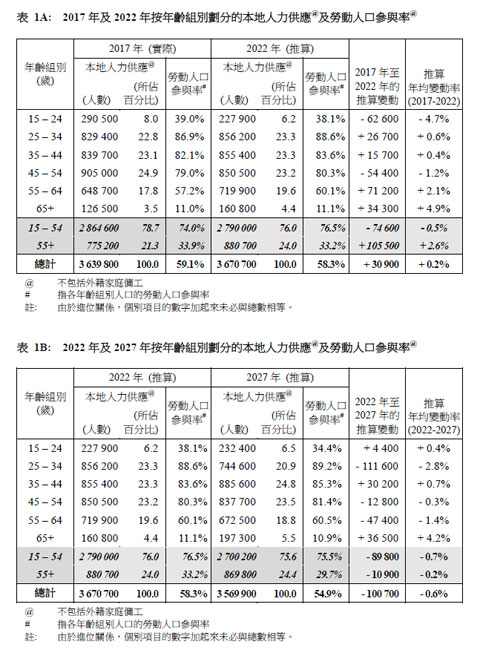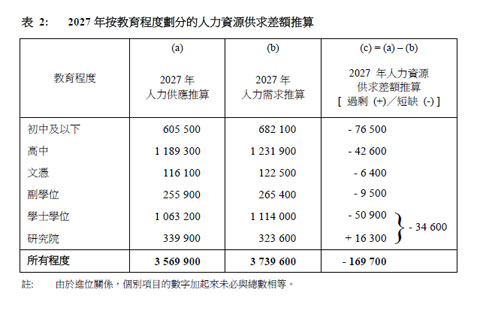To enhance and optimise human capital to cater for Hong Kong’s evolving development needs
19 May 2019
Our workforce is a precious resource of Hong Kong and the foundation of its economic development. With an ageing population and a shrinking workforce, Hong Kong is under pressure in terms of economic growth and long-term development. In the face of this big challenge, the Government and different sectors of the community must respond in a pragmatic and serious manner.
The Government is committed to enhancing our human resources planning to improve Hong Kong’s competitiveness. Since its establishment in April last year, the Human Resources Planning Commission (the Commission) has made vigorous efforts to examine various manpower issues.
The Key Findings of Manpower Projection to 2027 released a short while ago have assessed, at the macro level, the broad trends of Hong Kong’s future manpower supply and requirements, and projected the manpower resource balance. The findings can serve as a basis for gauging the manpower resource needs of Hong Kong.
The projection period of the Manpower Projection spans ten years (2017 to 2027). The key findings include the projected manpower supply, the projected manpower requirements and the projected manpower resource balance.

|

|
Manpower Supply Projection
An ageing population and low fertility will leave Hong Kong facing a shrinking workforce. Local manpower supply (equivalent to the labour force excluding foreign domestic helpers) is projected to increase from 3.64 million in 2017 to reach a plateau in 2019 to 2022 at 3.67 million to 3.68 million, and then continuously decrease to 3.57 million in 2027.
The respective percentages of people of different age groups, genders and education levels in the future manpower supply will gradually change. The manpower supply of older people will increase but that of younger ones will decrease. While the age-specific labour force participation rate (LFPR) for persons aged between 25 and 64 will rise, the number of elderly persons aged 65 or over in the population will increase remarkably by 670 000 during the period. The much expanded elderly population is expected to water down the overall LFPR from 59.1% in 2017 to 54.9% in 2027. Local female manpower supply is expected to have grown slightly by 2027, from 1.65 million in 2017 to 1.69 million in 2027 (an average annual growth rate of 0.2%). This is probably due to a more rapid growth of the female population and an increasing number of women remaining single or getting married at later ages. On the other hand, local male manpower supply is expected to decrease from 1.99 million in 2017 to 1.88 million in 2027 (an average annual decline rate of 0.6%).
Besides, owing to the increased popularity of higher education in Hong Kong, the manpower supply related to sub-degree, undergraduate degree and postgraduate degree qualifications is projected to grow. On the other hand, people who are at the secondary education level or below and belong to the post-war baby boomer generation will gradually retire. Some 150 000 workers with qualifications of upper secondary education and some 300 000 workers with qualifications of lower secondary education and below will retire during the projection period.
Manpower Requirement Projection
During the projection period, the overall manpower requirements of the local economy are expected to increase from 3.61 million in 2017 to 3.74 million in 2027, corresponding to an average annual growth rate of 0.3%.
As our economy moves towards high-quality and high value-added products and services, the relatively fast growing economic sectors in terms of manpower requirements will be Professional and Business Services (at an average annual growth rate of 1.4%); Information and Communications (1.2%); Financial Services (1.1%); Social and Personal Services (0.9%); Real Estate (0.8%); and Construction (0.5%).
It is worth noting that the wave of innovation and technology has swept through the world. There is an unstoppable trend in Hong Kong, as a knowledge-based and high value-added economy having a business environment focusing on innovation and professionalism, that enterprises will adopt automation and other technologies in their business processes. Given this important direction of Hong Kong’s economic development, it is projected that there will be corresponding changes in our future manpower requirements in terms of occupation pattern and education level. In this connection, the local labour force should continuously update and enhance their knowledge and skills. At the same time, we can also make use of technological development to ease the pressure of a shrinking workforce on Hong Kong’s economic growth, and help alleviate the manpower shortage of individual sectors.
According to the manpower projection, the proportion of workers in high-skilled occupation groups (viz. Managers and Administrators; Professionals; and Associate Professionals) will increase (from 42.8% in 2017 to 46.4% in 2027), whereas the proportion of non-high-skilled occupation groups (such as Clerical Support Workers; Craft and Related Workers; and Workers in the Elementary Occupations) will decrease from 57.2% to 53.6% during the same period. Similarly, during the projection period, the manpower requirement for workers with higher education qualifications will increase while that for workers with lower qualifications will diminish.
By comparing the projected manpower supply with the projected manpower requirements, we anticipate that there will be an overall shortfall of 169 700 by 2027. Basically, the shortfall will occur across all education levels: the lower secondary and below level will see the largest shortfall of 76 500 in 2027; while taken together, the first degree and postgraduate levels will face a shortage of 34 600.
The key findings of the manpower projection will help us understand the main characteristics of our workforce and explore ways to improve our manpower planning from a macro perspective. However, such projections have their limitations. Nowadays, global economic, technological and geopolitical environments are ever evolving and factors affecting future manpower supply and demand are constantly changing. It is always hard to predict how these inter-related rapid developments will impact on the future manpower requirements.
To keep pace with the changes in our highly flexible and responsive economic structure, our labour market must respond quickly. Many experts and scholars of the Commission opine that our economic development may be slackened by the long-term manpower shortage. Therefore, we must solve the problem through proper manpower planning, making the best use of our talent pool by avoiding skill mismatches and releasing the local workforce to the fullest extent. The Government will continue to take multi-pronged measures to create a conducive employment environment by providing incentives as well as diversified employment support services.
Women, ethnic minorities, new arrivals, persons with disabilities and retirees who wish to rejoin the job market constitute a major source of manpower supply for Hong Kong, and their potential for employment should not be overlooked. In fact, “everyone counts” in making up the shortfall in the local workforce.
For example, there are women who give up their work after having children owing to various worries. By implementing policy initiatives such as enhanced child care services, extended statutory maternity leave and improved family-friendly measures, the Government has been helping these women balance their family and work commitments, enabling them to consider rejoining the job market. This will help increase the local manpower supply. At the same time, the Government will also continue to encourage enterprises and society as a whole to promote family-friendly employment practices, thereby creating a conducive environment which enables women to make choices about their work.
In response to the rapid changes in the employment market, we must develop our pool of home-grown talent and facilitate upward mobility of our younger generation. Manpower training requires the mutual support and co-operation of employers, employees and training providers. The Government will continue to improve vocational education, enhance co-operation between the commercial and academic sectors in manpower training, actively facilitate the promotion of life planning at schools, promote various internship programmes, etc., with a view to nurturing talent and enhancing the quality of our workforce. For some industries with serious manpower shortage, the Government will also seriously explore the possibility of importation of labour.
The Government will continue to actively explore the way forward and open up room for development, using the latest manpower projection findings as reference data for co-ordinating policies and measures on human resources. To cope with future challenges, the Government will work with various sectors of the community to map out a blueprint for our human resources planning.

